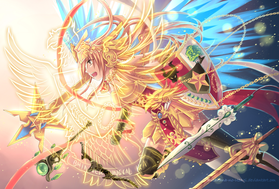Difference between revisions of "Garuda Pancasila"
(Added template) |
(Added templates) (Tag: invisibleCharacter) |
||
| Line 1: | Line 1: | ||
| − | {{ | + | {{Translation in progress|1=July 13, 2024|progress=60%|source=[[zhmoe:嘉鲁达·潘查希拉]]}} |
| + | {{Urgent improvement}} | ||
{{InfoBar | {{InfoBar | ||
|image = Garuda pancasila by butahana no usagi-d5s3qeg.png | |image = Garuda pancasila by butahana no usagi-d5s3qeg.png | ||
Latest revision as of 16:29, 13 July 2024

|
Translation in progress This article is currently being translated from zhmoe:嘉鲁达·潘查希拉; it may be incomplete, inaccurate or obfuscating. Moegirlpedia hopes that you can help with translating, proofreading, or copy editing this article. Progress:
60% This template was placed on July 13, 2024. The last edit was on 16:29, 13 July 2024 (UTC). |

|
Moegirlpedia reminds you that this article may be subject to large scale revision. New users are advised not to create new pages similar to this one.
If you know how to improve this article, you can try editing it.
|
 Artwork by ButahananoUsagi | |
| Garuda Pancasila | |
| Name | Garuda Pancasila |
| Other Names | Garuda |
| Origin | Indonesia |
“
Unity in diversity.
”
The Garuda Pancasila is the national emblem of Indonesia and one of the national symbols of Indonesia.
Introduction
The Garuda is a golden bird in Indian mythology. Pancasila refers to Indonesia's "Five Principles of National Founding" (the Five Principles of National Founding were originally put forward at the meeting of the "Independent Preparatory Committee" on June 1, 1945. According to the speech, in order to build Indonesia into a country where the whole world is for the public, it must implement five basic principles, namely the five principles of nation-building.
- The first principle is "nationalism", that is, Indonesia is a unified nation-state;
- The second principle is "internationalism". It is not that nationalism and the existence of nation-states are not recognized. This internationalism is based on nationalism;
- The third principle is "consensus", that is, the rights of Muslims are guaranteed through consultations and conferences;
- The fourth principle is "common prosperity", that is, an independent Indonesia should no longer have poverty, and the people of the whole country should be guaranteed a happy life with food and clothing (this requires not only political equality, but also economic practice equality).
- The fifth principle is "belief in Shinto", not only Hide the beliefs of the people, and each Indonesian people should believe in their own Shinto, and all the people must believe in an educated way, without religious prejudice, to make Indonesia a Shinto country.
The Garuda Pancasila was designed by Muhammad Hada. The original version was an anthropomorphic "Garuda", which was later modified to a golden eagle.
| |||||